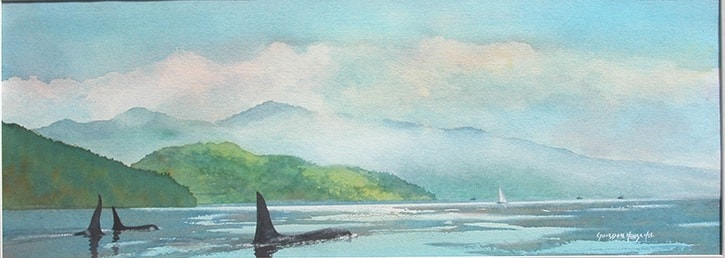This painting really has two subjects: the whales and the mountain. To find out the real name of each of them takes a little digging.
Orcas have been around long before humans hit the scene, often being considered a nuisance because they fed on the same fish we sought.
During the last few decades, when we first started becoming more aware of the complexity and individuality of this amazing creature, we began to realize they could be identified and that they moved about in families.
Painting them used to be easy because few people, myself included, could tell one whale or pod from another. During the seventies, Dr. Michael Bigg, a researcher from the Pacific Biological Station in Nanaimo, began to change all this by inventing a system of identification based on photographs. Whale watching has become a huge activity pursued by hundreds of thousands, with a great many of them becoming expert at recognizing exactly what they are viewing.
I have always used photos or videos for my reference in painting them, but I can no longer take my favourite shots of individuals and make up my own pod. It just wouldn’t be correct to do so. I try to use photos of pods and whales within those pods when I paint them and make notes when I am photographing them as to what pod it is.
Sometimes I have to check with the experts, in this case Larry Roy, the owner and operator of Discovery Expeditions.
Larry has spent endless hours with pods of whales on his kayak tours and assured me that the pod in this painting is A8. Before you try to identify individuals, it all begins by counting the total number of members within the pod and then the males and the females.
The other subject needing identification in the painting is the mountain. As long as I can remember I’ve heard it called “The Elephant” because of its shape. Back in 1978, as I sat in Ramona Knorn’s backyard in Kokish and painted it in oils, I inquired as to what the name of the imposing mountain was that faced the community. The answer was always the same, “Oh, that’s The Elephant”.
Its presence has probably been felt most of all by the many generations that have worked in its shadow. In the days when Kokish was still a vibrant community, The Elephant was still unlogged; its shape as the head of a gigantic pachyderm much more pronounced. Today it takes a more imaginative eye to see the resemblance, but it’s still there, particularly when viewed from the ocean. It is, in fact, a reliable landmark for ocean traffic since it can be recognized from afar.
Its proper name? Neither innovative nor imaginative, it is named Mt. Holsworth.
This painting is called Johnstone Strait Traffic and rightly so, for Johnstone Strait is a major ocean highway on the mid coast. Used by virtually all ocean-going vessels from skiffs to cruise ships, it is nonetheless a highway for the hundreds of orcas that frequent our waters each year and has made Johnstone Strait synonymous with whale watching.
Now why couldn’t they have called it Orca Strait?
Gordon Henschel owns an art gallery in Nimpkish Heights. www.henschel.ca.
